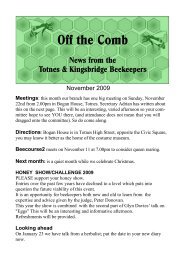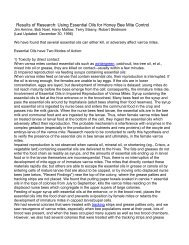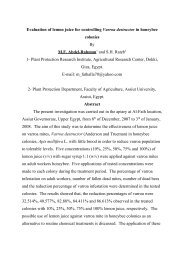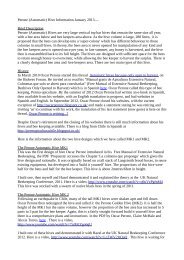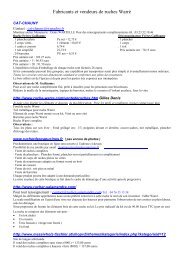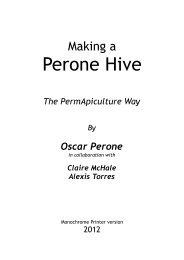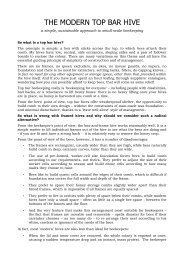You also want an ePaper? Increase the reach of your titles
YUMPU automatically turns print PDFs into web optimized ePapers that Google loves.
Observation<br />
Explal1lltion<br />
brood <strong>the</strong> cell contents would not be viscous. In both<br />
cases <strong>the</strong> dead brood is more often than not dehydrated<br />
and has <strong>the</strong> shape of brown scales adhering to <strong>the</strong><br />
inner cell walls. These extremely contagious diseases<br />
must be reported to <strong>the</strong> authorities.<br />
On a day of main flow one<br />
colony has not a single fanner<br />
near <strong>the</strong> hive entrance. In <strong>the</strong><br />
morning <strong>the</strong> latter is absolutely<br />
dry. Concurrently one observes<br />
strong colonies forming barbs<br />
before <strong>the</strong> hive (starvation<br />
barb). The bees still fly but do<br />
so feebly and aimlessly.<br />
This colony is suffering from extreme starvation. It<br />
has already absorbed <strong>the</strong> jelly of all <strong>the</strong> open brood.<br />
There are no longer any larvae. The capped brood<br />
begins to cool. If one does not feed immediately, it<br />
will not fly at all on <strong>the</strong> following day. Chilling of <strong>the</strong><br />
brood will follow, many bees will fall to <strong>the</strong> bottom<br />
board of <strong>the</strong> hive, hundreds of o<strong>the</strong>rs will die in <strong>the</strong><br />
cells and <strong>the</strong> queen will die last of all. This situation<br />
can arise when <strong>the</strong>re have been several days without<br />
a harvest or when one removes too much honey from<br />
colonies that lay a great many eggs. Even in August, a<br />
colony must be able to draw from plentiful supplies.<br />
Why?<br />
Certain colonies reduce <strong>the</strong>ir<br />
hive entrance by means of a<br />
curtain of propolis only leaving<br />
a small opening <strong>the</strong> size of a<br />
thumb.<br />
This occurs when <strong>the</strong> hive entrance is ei<strong>the</strong>r too wide<br />
or too high. A colony which does this to prevent <strong>the</strong><br />
wind and cold penetrating <strong>the</strong> hive in winter is not<br />
very strong.<br />
The colonies are tormented by<br />
wasps. Fights take place at <strong>the</strong><br />
hive entrance.<br />
Some years, <strong>the</strong> wasps are so numerous that <strong>the</strong>y<br />
seriously affect <strong>the</strong> harvest on days of main flow. One<br />
must set up wasps traps. Hundreds per day can be<br />
caught in a feeding flask containing beer or diluted<br />
fruit juice. Wasps are also attracted to <strong>the</strong> hive if <strong>the</strong><br />
dead bees in front of it are not regularly removed.<br />
Robbers attempt to slip inside<br />
<strong>the</strong> hive, sometimes in a very<br />
crafty manner. The alighting<br />
boards are <strong>the</strong>n well occupied<br />
by guardian bees.<br />
The danger posed by robbery is far greater in August<br />
than in April. Many foragers still attempt to bring<br />
something back before dying. One must reduce <strong>the</strong><br />
size of <strong>the</strong> hive entrance in time, in proportion to <strong>the</strong><br />
strength of <strong>the</strong> colony. The robbers are surprisingly<br />
52





